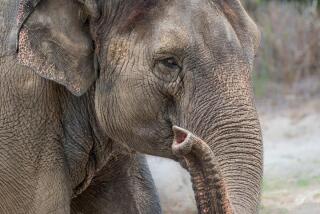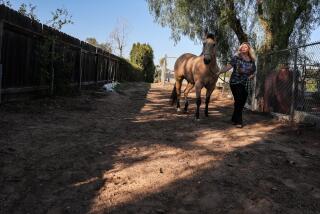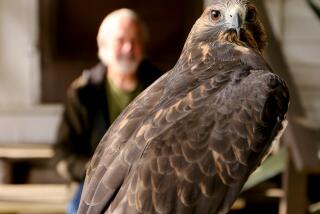Donkeys airlifted from Hawaii to California
Mark Meyers hasn’t slept for more than a day and his back is killing him, but he still has to wrangle a donkey who refuses to exit its horse trailer after a 2,500-mile flight from Kona, Hawaii. Dozens more wait behind it.
So Meyers pops an 800-milligram ibuprofen and gets down to work. First he starts pushing, but then he tries sweet-talking the beast. “Come on, girl!” he says. “Come and see your new home!”
Finally the jenny clambers down. She lifts her gray head and begins braying loudly. Immediately, hundreds of other donkeys join in, creating a discordant chorus that breaks the morning stillness in this scrubby mountain valley.
“That’s it!” Meyers booms. “Way to be a leader.”
In all, Meyers and his crew unloaded 120 donkeys flown from the Big Island to their new quarters at the Peaceful Valley Donkey Rescue, off a rural road north of Tehachapi. Saturday’s airlift marks a new chapter in the nearly two-century history of the Hawaiian donkeys and a new challenge for Meyers and his crew.
Once used to ferry sugar cane, coffee and other crops, the donkeys have lived wild for decades and now overpopulate the area. Meyers’ nonprofit rescue group agreed to take some.
What started as an act of compassion has become a calling for Meyers, 48, and his wife, Amy, 37.
Their life changed 12 years ago when he bought a donkey as a companion for Amy’s horse. They were taken by Izzy’s loving and friendly personality.
Soon, Meyers noticed other wandering donkeys that looked skinny or abandoned and took them in. Some were starved or abused, but Meyers said he learned that if he took his time, even the saddest cases would come around.
He remembers one badly abused jack that shook violently whenever the rancher approached. Each day Meyers sat in a corner of a stall quietly talking to the animal, moving closer with each visit. Finally, the donkey allowed him to feed it a carrot, and eventually, to stroke its back.
When his stalls began filling, Meyers set off to find adoptive homes for the animals. Next came contracts with state and federal wildlife agencies to take on wild donkeys that were being rounded up on federal lands.
Finally, the 6-foot, 4-inch electrical contractor threw himself into the donkey rescue business full time and created his nonprofit. Today the group works with adoption facilities in 22 states, supervising the rescue, rehabilitation and adoption of 2,000 donkeys nationwide. At any one time, there are as many as 325 donkeys at the ranch.
“It started to make [more] sense to stay here and talk to donkeys than to hop on [California Highway] 14 to Los Angeles,” he said.
In 2008, he heard that Texas authorities were shooting donkeys along the Rio Grande, the beast of burden now judged to be little more than a nuisance. He hired Tracy Miller to manage the California haven and moved his wife and children to Texas and opened a second rescue facility, this one on 260 acres of scrub.
Their efforts in the Lone Star state became crucial this year as prolonged drought drove up the price of hay and water, and ranchers began abandoning their animals.
Meyers estimates he’s rescued 500 donkeys in Texas since March alone. “People are loading them up on trucks and driving two or three counties over and just letting them go along some highway,” he said. “Someone will wake up and come out and see a dozen donkeys in their frontyard.”
The Hawaiian transport was a more complicated affair.
Working with the Humane Society of the United States and Kona veterinarian Brady Bergin, crews captured and castrated the males to prepare them for the journey. Hawaiian volunteers trucked the bristle-haired beasts to the airport, where they were loaded into the belly of a 747 cargo jet for the flight to Los Angeles.
Another crew met them at the airport and loaded the animals onto six trailers early Saturday for the rumbling 120-mile journey north to Tehachapi. Meyers declared the transfer a success. The public can adopt the animals for $200 each at an Oct. 29 open house at the Tehachapi ranch.
“This is a good bunch,” he said as the donkeys began munching piles of hay.
Donkeys have been part of the Big Island’s history for nearly two centuries. Introduced by the British, the strong, sure-footed creatures were used by Kona coffee bean growers to carry bulging bags from mountain farms to coastal ports. Every farm family had one, said Fred Duerr, who managed the nearby Kona Village Resort for 38 years.
At night the social animals would grow lonely and bray to one another, filling the Hawaiian night air with a cacophony of song, he said. Locals dubbed them the Kona Nightingales. When World War II ended, farmers switched to the sudden surplus of Jeeps and turned their donkeys loose on the lava flows, Duerr said.
They thrived in the wild until the Kona Coast began to erupt with hotels and golf courses. The donkeys were eating landscaping, breaking fences and sometimes being hit by cars as they descended Kona’s slopes to lick salt off of the sea rocks.
Eventually most of them were resettled in Waikoloa, where they roamed free until, once again, they became a nuisance, breaking down barriers and foraging close to roads and residential areas.
Meyers and his wife oversaw the airlift, flying from Texas to Hawaii and then to Los Angeles. Meyers said he wanted to make sure things were done right. He personally loaded most of the animals in Hawaii, he said.
You might say Meyers is as stubborn as his donkeys — but don’t say it to his face.
He doesn’t like the stereotype of a donkey as a dumb, recalcitrant animal. It is not only inaccurate, he says, but a disservice to a breed that helped build America in its first century.
“People tend to admire determination in other humans, but not at all in donkeys,” Meyers writes on the group’s website. “When donkeys show the tenacity that kept them alive in the wild, people call them stubborn. But if you think about it, being ‘stubborn’ is not always a bad thing.”
catherine.saillant@latimes.com
More to Read
Sign up for The Wild
We’ll help you find the best places to hike, bike and run, as well as the perfect silent spots for meditation and yoga.
You may occasionally receive promotional content from the Los Angeles Times.







